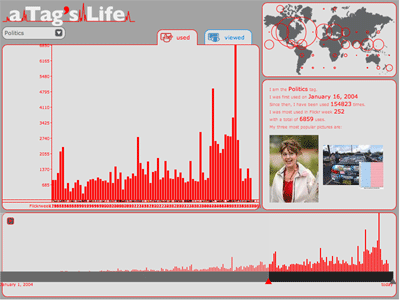

An almost all too perfect follow-up to the 24 Hour Program at the Guggenheim this evening, this online exhibition hosted by Utrecht's Impakt also examines time, but through the lens of the internet. Time and technology have a long history together, a fact the curatorial statement acknowledges, and "It's About Time" organized by Sabine Niederer shifts its focus to the present with two projects that specifically attend to the contemporary reality of the web (such as 2.0 technologies) and time. The first, titled A Tag's Life and produced by the team George Holsheimer, Mirjam ter Linden, Daan Odijk, Patri Sadiqah, and Raoul Siepers, indicates trends by visualizing the lifespan of tags used on Flickr over time. The tendencies that emerge are generally expected, like the exponential use of the tags "politics" and "Obama" around this year's U.S. Presidential election. With the plethora of data visualization projects out there, this one isn't exactly groundbreaking, but could prove to be a useful tool to access Flickr. Unfortunately, you must "suggest" tags in order to generate graphs, which limits one's ability to take full advantage of the site. The second project, World At Work by Theo Deutinger, extends the boundaries of the clock to include both the macro level of the universe and the micro level of the working day on Earth. The site opens up on the Milky Way, and the visitor must zero in on Earth in order to draw up the number of people globally working 9-5 shifts by location. By showing how many people in the world are at work simultaneously, the site reveals the rhythm of labor worldwide, at any given moment. Deutinger, an architect, created the project as part of an ongoing series dealing with the globalization. In creating this sort of clock, he hopes to illuminate global labor patterns that give rise to a picture of worldwide productivity, one that would dictate its own sense of time. World At Work leaves a few unanswered questions, namely it is unclear where Deutinger derives his data, which is a key component.

